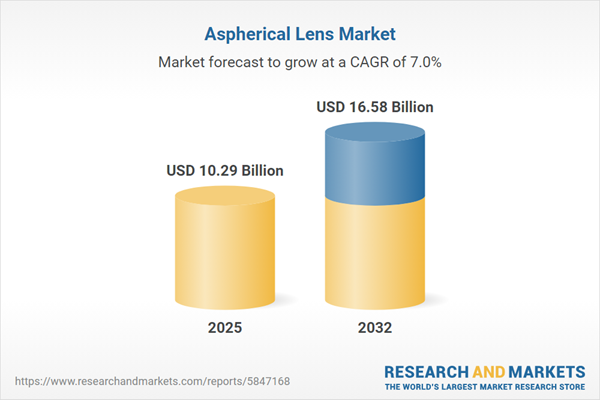Speak directly to the analyst to clarify any post sales queries you may have.
As organizations navigate increasingly complex operational environments, aspherical lens technology stands out as a critical asset for enhancing optical performance, reliability, and adaptability. Senior decision-makers across sectors are focusing on integrating these advanced components to maintain robust, future-ready portfolios in key technical fields.
Market Snapshot: Global Aspherical Lens Market Size and Growth
The global aspherical lens market demonstrates consistent expansion, fueled by continual demand from automotive, medical device, and electronics industries that require high-precision optics. In 2024, the market value reached USD 9.62 billion, with projections indicating growth to USD 10.29 billion by 2025 and USD 16.58 billion by 2032. This represents a steady compound annual growth rate of 7.03%. Market momentum reflects ongoing modernization, stringent quality benchmarks, and significant investment in research and innovation within optics. The aspherical lens market is poised to remain essential as industries adapt to dynamic technical standards and operational needs.
Scope & Segmentation of the Aspherical Lens Market
- Material Types: Borosilicate glass and crown glass provide clarity and durability for industrial scenarios where reliability is prioritized. Polycarbonate and PMMA offer options for procurement professionals managing weight-sensitive or high-volume requirements, securing a balance between cost efficiency and system performance.
- End Uses: Aspherical lenses are pivotal in automotive lighting, lidar in autonomous vehicles, mobile device cameras, precision medical imaging, and industrial lasers. These roles support technical demands in sectors where accuracy and longevity are paramount.
- Distribution Channels: Organizations have flexibility in sourcing through direct arrangements with manufacturers, specialized distributors, e-commerce, or digital procurement systems, which increases supply chain resilience and sourcing adaptability.
- Applications: Usage spans diagnostic imaging, industrial automation, and high-precision laser manufacturing, enabling consistent output and ongoing advancement in process optimization for mission-critical processes.
- Price Ranges: Economy, standard, and premium tiered pricing allows buyers to align procurement with project size and system performance requirements, helping control total costs while supporting a wide spectrum of installations.
- Regions: Varied regulatory environments, capital allocations, and manufacturing strategies shape adoption rates in the Americas, Europe, Middle East, Africa, and Asia-Pacific, influencing supply decisions and regional growth dynamics.
- Leading Companies: Industry benchmarks are continually established by major players, including Canon Inc., Nikon Corporation, Carl Zeiss AG, SCHOTT AG, Hoya Corporation, Corning Incorporated, Sumitomo Electric Industries, Ltd., Ohara Corporation, Edmund Optics, Inc., and Kowa Company, Ltd., fostering sector-wide innovation and raising operational standards.
Key Takeaways for Senior Decision-Makers
- Adopting aspherical lenses into advanced imaging solutions enables organizations to better align with evolving technical and customer expectations across critical industries, including automotive and healthcare.
- Innovations in manufacturing—such as diamond turning and thermal molding—support production of compact, energy-efficient optics that are adaptable to shifting market and application requirements.
- Specifying engineered polymers and specialty glass in designs extends product lifecycle and ensures compliance for installations in safety-regulated applications subject to heightened scrutiny.
- Employing AI-driven metrology and customized software expedites the product development cycle, empowering teams to accelerate new product launches and maximize commercialization speed.
- Strategic collaboration between technology vendors, contract manufacturers, and internal procurement teams can improve competitiveness and facilitate access to niche or emerging segments in the optical market.
Tariff Impact: Navigating US Trade Policy Shifts
Shifts in US tariffs on imported optics components have led organizations to reassess procurement and diversify their sourcing models to minimize risk. By expanding supplier networks, leveraging digital procurement platforms, and reviewing product portfolios, decision-makers can mitigate supply chain interruptions and address compliance with new regulatory requirements.
Methodology & Data Sources
This analysis is grounded in direct interviews with industry executives and technical experts, proprietary procurement data, and feedback from leading optics vendors. Secondary sources include industry periodicals, regulatory bodies, and international trade documentation. Findings are validated by an expert review panel to ensure reliability and precision.
Why This Report Matters for Senior Executives
- Delivers practical insight for capital planning, process improvement, and risk management in a dynamic optics sector.
- Clarifies key trends and operational imperatives shaping investment and technology adoption strategies.
- Facilitates robust benchmarking, enabling organizations to proactively anticipate market shifts and evolving client needs.
Conclusion
Senior executives who apply the insights of this report will position their organizations effectively within the optics sector, ensuring responsiveness to market shifts and advancing operational objectives as industry challenges evolve.
Additional Product Information:
- Purchase of this report includes 1 year online access with quarterly updates.
- This report can be updated on request. Please contact our Customer Experience team using the Ask a Question widget on our website.
Table of Contents
3. Executive Summary
4. Market Overview
7. Cumulative Impact of Artificial Intelligence 2025
Companies Mentioned
The companies profiled in this Aspherical Lens market report include:- Canon Inc.
- Nikon Corporation
- Carl Zeiss AG
- SCHOTT AG
- Hoya Corporation
- Corning Incorporated
- Sumitomo Electric Industries, Ltd.
- Ohara Corporation
- Edmund Optics, Inc.
- Kowa Company, Ltd.
Table Information
| Report Attribute | Details |
|---|---|
| No. of Pages | 180 |
| Published | November 2025 |
| Forecast Period | 2025 - 2032 |
| Estimated Market Value ( USD | $ 10.29 Billion |
| Forecasted Market Value ( USD | $ 16.58 Billion |
| Compound Annual Growth Rate | 7.0% |
| Regions Covered | Global |
| No. of Companies Mentioned | 11 |









